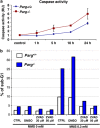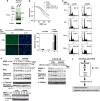PARG dysfunction enhances DNA double strand break formation in S-phase after alkylation DNA damage and augments different cell death pathways
- PMID: 23744356
- PMCID: PMC3698538
- DOI: 10.1038/cddis.2013.133
PARG dysfunction enhances DNA double strand break formation in S-phase after alkylation DNA damage and augments different cell death pathways
Abstract
Poly(ADP-ribose) glycohydrolase (PARG) is the primary enzyme responsible for the degradation of poly(ADP-ribose). PARG dysfunction sensitizes cells to alkylating agents and induces cell death; however, the details of this effect have not been fully elucidated. Here, we investigated the mechanism by which PARG deficiency leads to cell death in different cell types using methylmethanesulfonate (MMS), an alkylating agent, and Parg(-/-) mouse ES cells and human cancer cell lines. Parg(-/-) mouse ES cells showed increased levels of γ-H2AX, a marker of DNA double strand breaks (DSBs), accumulation of poly(ADP-ribose), p53 network activation, and S-phase arrest. Early apoptosis was enhanced in Parg(-/-) mouse ES cells. Parg(-/-) ES cells predominantly underwent caspase-dependent apoptosis. PARG was then knocked down in a p53-defective cell line, MIAPaCa2 cells, a human pancreatic cancer cell line. MIAPaCa2 cells were sensitized to MMS by PARG knockdown. Enhanced necrotic cell death was induced in MIAPaCa2 cells after augmenting γ-H2AX levels and S-phase arrest. Taken together, these data suggest that DSB repair defect causing S-phase arrest, but p53 status was not important for sensitization to alkylation DNA damage by PARG dysfunction, whereas the cell death pathway is dependent on the cell type. This study demonstrates that functional inhibition of PARG may be useful for sensitizing at least particular cancer cells to alkylating agents.
Figures





Similar articles
-
Parg deficiency confers radio-sensitization through enhanced cell death in mouse ES cells exposed to various forms of ionizing radiation.Biochem Biophys Res Commun. 2013 May 24;435(1):100-6. doi: 10.1016/j.bbrc.2013.04.048. Epub 2013 Apr 23. Biochem Biophys Res Commun. 2013. PMID: 23624507
-
Silencing of poly(ADP-ribose) glycohydrolase sensitizes lung cancer cells to radiation through the abrogation of DNA damage checkpoint.Biochem Biophys Res Commun. 2013 Nov 29;441(4):793-8. doi: 10.1016/j.bbrc.2013.10.134. Epub 2013 Nov 6. Biochem Biophys Res Commun. 2013. PMID: 24211580
-
Role of poly(ADP-ribose) glycohydrolase in the regulation of cell fate in response to benzo(a)pyrene.Exp Cell Res. 2012 Mar 10;318(5):682-90. doi: 10.1016/j.yexcr.2012.01.007. Epub 2012 Jan 11. Exp Cell Res. 2012. PMID: 22266578
-
Roles of poly(ADP-ribose) glycohydrolase in DNA damage and apoptosis.Int Rev Cell Mol Biol. 2013;304:227-81. doi: 10.1016/B978-0-12-407696-9.00005-1. Int Rev Cell Mol Biol. 2013. PMID: 23809438 Review.
-
New Insights into the Roles of NAD+-Poly(ADP-ribose) Metabolism and Poly(ADP-ribose) Glycohydrolase.Curr Protein Pept Sci. 2016;17(7):668-682. doi: 10.2174/1389203717666160419150014. Curr Protein Pept Sci. 2016. PMID: 27817743 Review.
Cited by
-
The interplay of TARG1 and PARG protects against genomic instability.Cell Rep. 2023 Sep 26;42(9):113113. doi: 10.1016/j.celrep.2023.113113. Epub 2023 Sep 6. Cell Rep. 2023. PMID: 37676774 Free PMC article.
-
Molecular Mechanisms of Parthanatos and Its Role in Diverse Diseases.Int J Mol Sci. 2022 Jun 30;23(13):7292. doi: 10.3390/ijms23137292. Int J Mol Sci. 2022. PMID: 35806303 Free PMC article. Review.
-
Poly(ADP-ribose) Glycohydrolase Inhibition Sequesters NAD+ to Potentiate the Metabolic Lethality of Alkylating Chemotherapy in IDH-Mutant Tumor Cells.Cancer Discov. 2020 Nov;10(11):1672-1689. doi: 10.1158/2159-8290.CD-20-0226. Epub 2020 Jun 30. Cancer Discov. 2020. PMID: 32606138 Free PMC article.
-
PARG is dispensable for recovery from transient replicative stress but required to prevent detrimental accumulation of poly(ADP-ribose) upon prolonged replicative stress.Nucleic Acids Res. 2014 Jul;42(12):7776-92. doi: 10.1093/nar/gku505. Epub 2014 Jun 6. Nucleic Acids Res. 2014. PMID: 24906880 Free PMC article.
-
Radiosensitization with an inhibitor of poly(ADP-ribose) glycohydrolase: A comparison with the PARP1/2/3 inhibitor olaparib.DNA Repair (Amst). 2018 Jan;61:25-36. doi: 10.1016/j.dnarep.2017.11.004. Epub 2017 Nov 22. DNA Repair (Amst). 2018. PMID: 29179156 Free PMC article.
References
-
- Sugimura T. Poly(adenosine diphosphate ribose) Prog Nucleic Acid Res Mol Biol. 1973;13:127–151. - PubMed
-
- Meyer-Ficca ML, Meyer RG, Coyle DL, Jacobson EL, Jacobson MK. Human poly(ADP-ribose) glycohydrolase is expressed in alternative splice variants yielding isoforms that localize to different cell compartments. Exp Cell Res. 2004;297:521–532. - PubMed
-
- Fujihara H, Ogino H, Maeda D, Shirai H, Nozaki T, Kamada N, et al. Poly(ADP-ribose) Glycohydrolase deficiency sensitizes mouse ES cells to DNA damaging agents. Curr Cancer Drug Targets. 2009;9:953–962. - PubMed
-
- Oka S, Kato J, Moss J. Identification and characterization of a mammalian 39-kDa poly(ADP-ribose) glycohydrolase. J Biol Chem. 2006;281:705–713. - PubMed
Publication types
MeSH terms
Substances
LinkOut - more resources
Full Text Sources
Other Literature Sources
Research Materials
Miscellaneous

